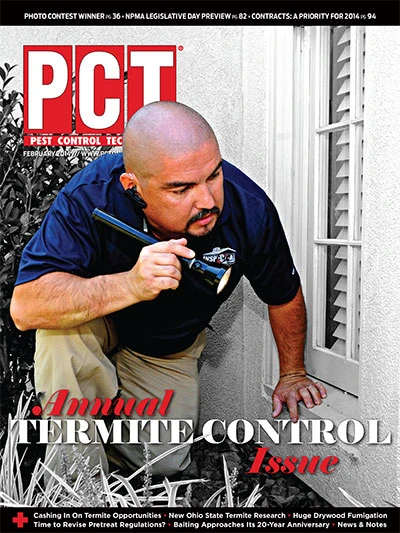 Not much has changed since standards for termite pretreatments were established in the 1940s and ’50s. The basic theory behind these practices is that if you put enough insecticide onto the soil underneath a structure, it stops termites from entering the structure. Specifically, the soil under the foundation of a building should be covered with termiticide at a rate of 1 gallon per 10 square feet.
Not much has changed since standards for termite pretreatments were established in the 1940s and ’50s. The basic theory behind these practices is that if you put enough insecticide onto the soil underneath a structure, it stops termites from entering the structure. Specifically, the soil under the foundation of a building should be covered with termiticide at a rate of 1 gallon per 10 square feet.
Over the years, issues have surfaced as a result of this practice, spurring some NPMA members, PMPs, regulators, researchers, manufacturers and other stakeholders to come forward with concerns. These individuals formed the Blue Ribbon Termite Task Force in the fourth quarter of 2012, with intentions of either developing new recommendations for pretreatment applications or confirming the validity of established practices. The task force is led by Rick Bell, vice president of government affairs and industry stewardship, Arrow Exterminators, Atlanta.
NPMA Executive Vice President Bob Rosenberg, who spearheaded the formation of the task force, explains, “If all stakeholders come to a consensus on what needs to be done, we can approach the EPA together, knowing that our recommendations won’t be challenged by one group or another. We’ll have a reasonably good chance of persuading EPA to do what needs to be done quickly.”
Addressing the Issues.
Most would agree that standards and practices that have been in place for six or seven decades deserve a fresh look because…well, just because. But there are a few very specific reasons the Termite Task Force feels this effort is warranted.
First, says Steve Dwinell, assistant director of the Division of Agricultural Environmental Services of the Florida Department of Agriculture and Consumer Services, who broached the subject at meetings last year, there is a question about how effective this application practice is. The standardized USDA Forest Service test used to measure efficacy may show positive results in a test plot, but it can’t take into account the activities that can compromise the application at a construction site before a foundation is poured, he says.
Brian Forschler, professor of entomology at the University of Georgia, agrees. “The timing of the termiticide application has to be perfect for it to be effective,” he says. “Since you’re spraying the top of the soil’s surface, if anyone walks or drives over it, the insecticide is disturbed. This happens all the time: Pesticides are applied hours or even days before the slab is poured, and the soil gets disturbed in a number of ways.”
Add to this the fact that the industry isn’t using the same kinds of persistent chemicals it was a half-century ago. Back then, PMPs could offer lifetime guarantees that termites would never appear. The reality today is that homeowners can expect termite activity to resume five to seven years after construction, some experts say.
“What do we do then?” asks Dwinell. “As Brian Forschler has pointed out for years, we don’t tear the house down to retreat the soil. We find the source and treat it or use perimeter treatments along with treatments of critical areas. These are very effective solutions. So our question is, couldn’t we use the same treatment protocol in the preconstruction phase?”
One more thing: Many stakeholders say current pretreatment regulations are giving the industry a black eye by making costs prohibitive to doing good business. It’s expensive to apply 250 gallons or more of insecticide under a house or 100,000 gallons under a shopping center. Builders traditionally look for the lowest-cost pest management provider to keep overall costs down.
“What ends up happening is that we have regulators, who are working in the interest of protecting consumers, basically hiding in the bushes to make sure PMPs are following label guidelines,” says Forschler. “Yet the practice they’re enforcing may not even be relevant anymore. These are the types of issues the task force is addressing.”
The author is a frequent contributor to PCT.
Editor’s note: PCT will continue to report on the Blue Ribbon Termite Task Force as developments occur.

Explore the February 2014 Issue
Check out more from this issue and find your next story to read.
Latest from Pest Control Technology
- Moneypenny is a Provider of Virtual Receptionists
- Video: Top 10 PCT Photo Contest Finalists
- Massey Services Expands with Southeast Commercial Region
- Pest Management Foundation Announces Kevin J. Burns Scholarship
- How to Identify Clover Mites
- Termite Threat Halted in Southern Florida
- PCT Media Group Adds Managing Editor Katie Hobbins
- Evens Clerjuste on Team Communication as Company Growth Point





